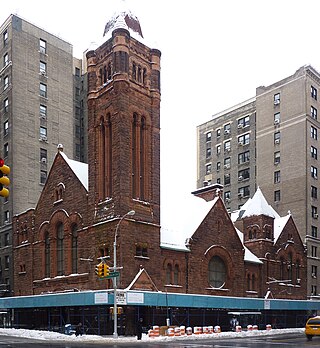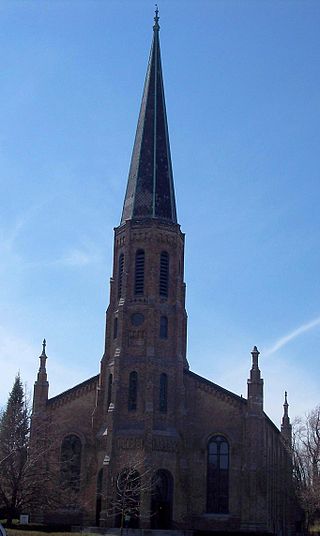Josiah Cleaveland Cady or J. Cleaveland Cady, was an American architect who is known for his Romanesque and Rundbogenstil style designs. He was also a founder of the American Institute of Architects.

Robert Henderson Robertson was an American architect who designed numerous houses, institutional and commercial buildings, and churches.
Minard Lafever (1798–1854) was an American architect of churches and houses in the United States in the early nineteenth century.

Edgehill Church at Spuyten Duyvil is a former United Church of Christ parish church located at 2550 Independence Avenue in the Spuyten Duyvil neighborhood of The Bronx, New York City. Its congregation was founded in 1869 as the mission chapel affiliated with the Riverdale Presbyterian Church, serving the workers at the nearby Johnson Iron Foundry. The church, described by the AIA Guide to New York City as a "picturesque eclectic sanctuary", was designed by architect Francis Kimball in a mixture of styles – Romanesque Revival, Tudor Revival and Shingle style – and was built from 1888–1889. It features stained glass windows designed by Louis Comfort Tiffany.

First Presbyterian Church, incorporated as the Congregational Society of Brockport, is a historic Presbyterian church located at Brockport in Monroe County, New York. It is a Greek Revival–style edifice built in 1852. The main block of the building is four bays long and three bays wide, constructed of red brick on a sandstone foundation. It features a three-stage tower with an octagonal drum from which the spire rises. The main worship space has a meeting house plan with a three sided upper gallery supported by fluted Doric columns.

Brick Presbyterian Church Complex, now known as Downtown United Presbyterian Church, is a historic Presbyterian church complex located at Rochester in Monroe County, New York. The complex includes the Brick Church and Church School, attached Brick Church Institute building (1909–1910), and Taylor Chapel (1941). The Brick Church and Church School was designed in 1860 as an Early Romanesque Revival–style edifice by Rochester architect Andrew Jackson Warner (1833–1910). His son, J. Foster Warner (1859–1937), modified the church structure to the Lombard Romanesque form in 1903.

Union Presbyterian Church, also known as First Presbyterian Church of Wheatland, is a historic Presbyterian church located at Scottsville in Monroe County, New York. It is a mid-19th-century vernacular Romanesque Revival–style building. It is composed of a three- by five-bay frame church with a 1+1⁄2-story rear wing that houses classrooms, offices, and kitchen facilities.

Chapin Memorial Church is a historic Universalist church at 12 Ford Avenue in Oneonta, Otsego County, New York. It was built in 1894 and is a one and a half-story brick building on a tall, cut stone foundation. The facade consists of two parts: the main body of the church and the engaged three stage tower and entrance bay. It is characterized by an eclectic design that combines features characteristic of the Romanesque, Gothic Revival, and Queen Anne styles.

West-Park Presbyterian Church is a Romanesque Revival Presbyterian church located on the corner of Amsterdam Avenue at 86th Street on the Upper West Side of Manhattan in New York City. It consists of a main sanctuary and chapel.

The Greenwich Avenue Historic District is a historic district representing the commercial and civic historical development of the downtown area of the town of Greenwich, Connecticut. The district was listed on the National Register of Historic Places on August 31, 1989. Included in the district is the Greenwich Municipal Center Historic District, which was listed on the National Register the year before for the classical revival style municipal buildings in the core of Downtown. Most of the commercial buildings in the district fall into three broad styles, reflecting the period in which they were built: Italianate, Georgian Revival, and Commercial style. The district is linear and runs north–south along the entire length of Greenwich Avenue, the main thoroughfare of Downtown Greenwich, between U.S. Route 1 and the New Haven Line railroad tracks.

Lafayette Avenue Presbyterian Church is a historic Presbyterian church complex located at 875 Elmwood Ave, Buffalo in Erie County, New York. The complex consists of the large cruciform-plan church building that was built in 1894 with an attached rear chapel. Adjoining them is the Community House that constructed of brick in the Tudor Revival style, that was built in 1921. The main church building is constructed of Medina sandstone with a terra cotta tile roof in the Romanesque Revival style. It features a 120-foot-tall (37 m), square bell tower with a pyramidal roof. The church cost $150,000 to build and has a capacity of 1,000 people
The Conyers Residential Historic District is an irregularly-shaped historic district in Conyers, Georgia, the only city in Rockdale County, Georgia, located 24 miles east of Atlanta. The district's development dates from the 1840s.

The former Swedish Baptist Church is a historic building located on the east side of Davenport, Iowa, United States. The congregation was organized in 1883 in the city's Swedish neighborhood and included about 50 people. The building was originally a Presbyterian Church and was moved here from its original location at Eleventh and Scott Streets. In the 1920s it became Second Baptist Church and by the 1930s it was renamed Grand Avenue Baptist Church. The building subsequently housed other denominations, including the Mennonites, and now houses Kingdom Generation Church.

East Avenue Tabernacle Associate Reformed Presbyterian Church, also known as the Great Aunt Stella Center, is a historic Associate Reformed Presbyterian church located at 927 Elizabeth Street in Charlotte, Mecklenburg County, North Carolina. It was designed by architect James M. McMichael in a Classical Revival style. It consists of a two-story sanctuary, built in 1914, and a four-story educational wing added to the south side of the sanctuary in 1925. The sanctuary has a Greek cross plan with a central octagon with shallow two-story wings that terminate in low parapeted walls. The sanctuary is topped by a copper dome and has a monumental porch with a brick pediment. In 1998 East Avenue Tabernacle merged with the Craig Avenue Associate Reformed Presbyterian Church. Ultimately the church became the Craig Avenue Tabernacle A.R.P. Church. Thus ironically through the years the name changed from East to Craig Avenue. The building now houses a community center and charter school.

College Square Historic District is a nationally recognized historic district located on a bluff north of downtown Davenport, Iowa, United States. It was listed on the National Register of Historic Places in 1983. The district derives it name from two different colleges that were located here in the 19th century.

First Presbyterian Church is a historic Presbyterian church located at Hill and East Streets in Keytesville, Chariton County, Missouri. It was built in 1853, and is a one-story, Classical Revival style frame building with a turn-of-the-20th century Romanesque Revival derivative style addition. It features a two-story plus belfry tower.
This is a timeline and chronology of the history of Brooklyn, New York. Brooklyn is the most populous of New York City's boroughs, and was settled in 1646.

The Asbury Historic District is a 288 acres (117 ha) historic district encompassing the community of Asbury in Franklin Township of Warren County, New Jersey. It is bounded by County Route 632, County Route 643, Maple Avenue, Kitchen Road, and School Street and extends along the Musconetcong River into Bethlehem Township of Hunterdon County. It was listed on the National Register of Historic Places on March 19, 1993 for its significance in architecture, industry, religion, community development, politics/government, and commerce. The district includes 141 contributing buildings, a contributing structure, two contributing sites, and four contributing objects.

The Westminster Presbyterian Church is a historic Presbyterian church located in the Delaware Avenue neighborhood of Buffalo, Erie County, New York. The Romanesque Revival building completed in 1859 features a number of exception stained glass windows and is a contributing property to the Delaware Avenue Historic District designated in 1974.

The First Presbyterian Church is located at 57 E. Park Place in the town of Morristown in Morris County, New Jersey. The congregation started worship here in 1733. It received a royal charter from George II of Great Britain in 1756. The current church building was erected in 1894. The stone building features Romanesque Revival architecture and works by Louis Comfort Tiffany. The church was added to the National Register of Historic Places, listed as a contributing property of the Morristown District, on October 30, 1973.






















